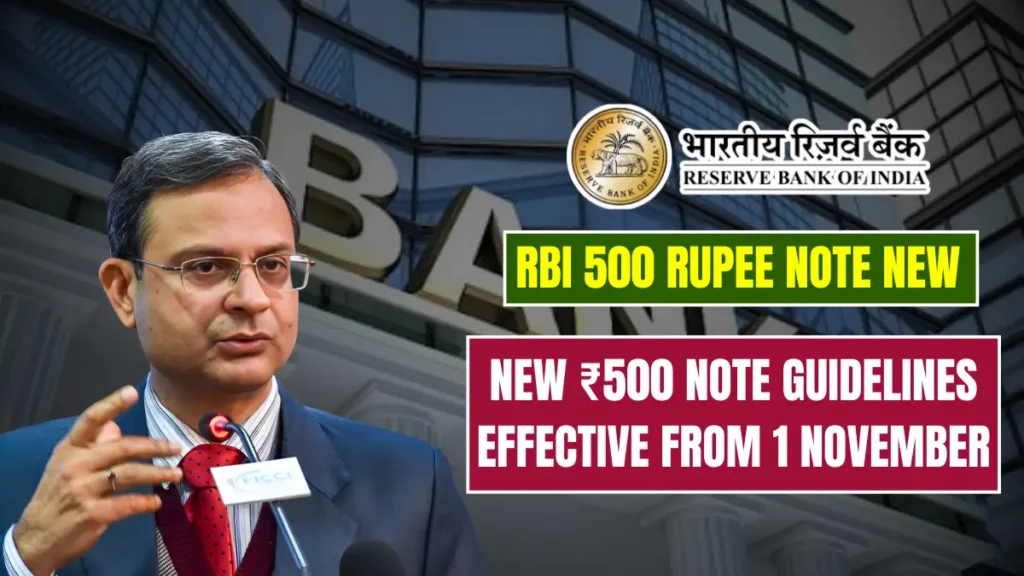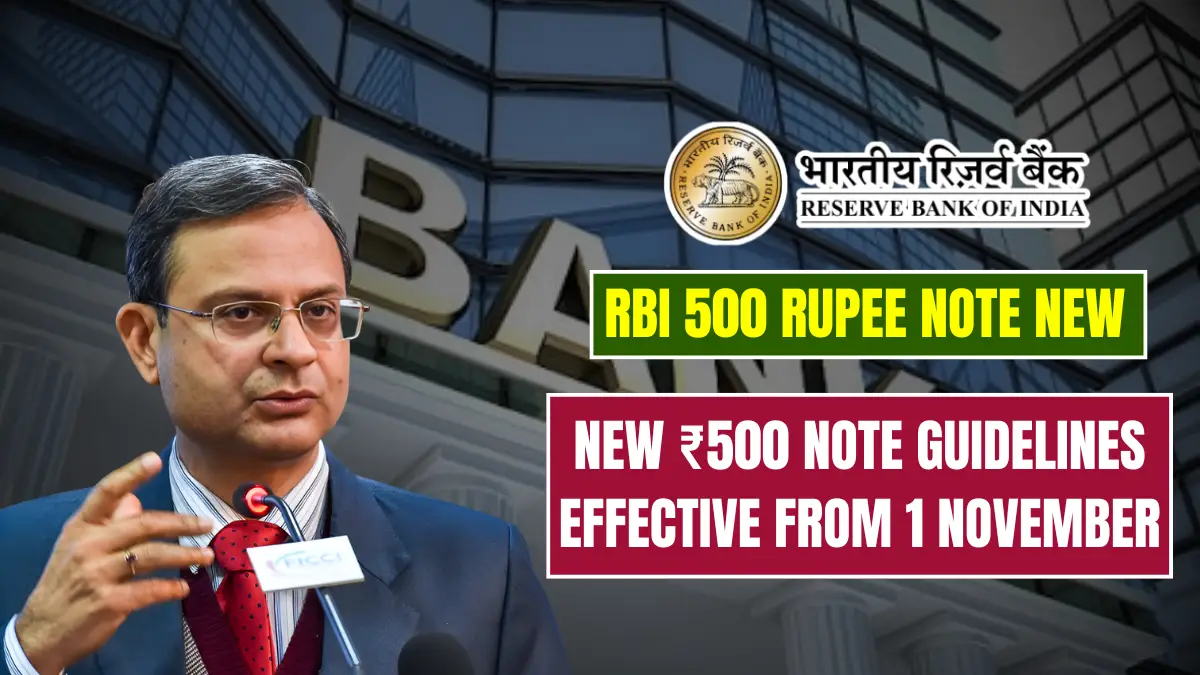RBI 500 Rupee Note New Rule – The Reserve Bank of India (RBI) is set to implement important changes to the ₹500 currency note, with new rules scheduled to come into effect from November 1. These new guidelines are part of the RBI’s broader effort to strengthen the currency system, reduce counterfeit currency, and promote transparency within the financial sector. With these changes coming into play, both consumers and businesses will need to understand and adapt to the new guidelines to avoid disruptions.
In this post, we will discuss the recent developments regarding the ₹500 note, the new rules governing its usage, and the steps that individuals and businesses need to follow to ensure smooth adaptation to these guidelines.

The ₹500 Note: A Significant Denomination in India’s Financial System
To understand the importance of these changes, it’s essential to look at the role the ₹500 note plays in India’s economy. Introduced in 1987 and later redesigned in 2016 following the demonetization of high-value currency notes, the ₹500 note is one of the most widely circulated and commonly used denominations in the country. It facilitates large-value transactions, especially in a cash-heavy economy like India.
The 2016 redesign brought forth a new set of security features, making it more difficult for counterfeiters to replicate. These features included the addition of a security thread, watermarks, and latent images. Despite these updates, issues surrounding counterfeit currency and a growing preference for digital payments led to further revisions in the ₹500 note’s security features and circulation guidelines.
New Guidelines for the ₹500 Note: What to Expect from November 1
From November 1, the RBI will introduce new rules concerning the circulation, usage, and exchange of ₹500 notes. While these guidelines do not overhaul the entire system, they are significant enough to warrant attention from the public. These changes are primarily aimed at reducing counterfeit currency, curbing black money circulation, and encouraging the public to adopt digital payments. Here are the most important aspects of these new guidelines:
Updated Security Features in the New ₹500 Notes
One of the key changes that the RBI is introducing is the incorporation of enhanced security features in the ₹500 note. This move is aimed at making it more difficult for counterfeiters to forge these notes. The updated notes will come with advanced security elements that will be visible both to the naked eye and under ultraviolet light, helping people easily distinguish between genuine and fake currency.
The new security features will include an updated security thread, watermarks, microprinting, and latent images. These elements have been incorporated to make it easier for individuals and businesses to verify the authenticity of the currency. As counterfeit currency has been a persistent issue, particularly in rural areas, these improvements are expected to boost confidence in the Indian currency system.
Changes in Withdrawal and Exchange Limits
As part of the new rules, the RBI has also revised the withdrawal and exchange limits for ₹500 notes. In the past, there were few restrictions on how many ₹500 notes one could exchange or withdraw in one go, but the new guidelines are designed to limit the amount of high-value currency an individual can exchange or withdraw at a time. These revised limits aim to prevent the hoarding of large sums of money in cash and help combat the circulation of black money.
The exact limits on withdrawal or exchange of ₹500 notes will vary depending on the nature of the transaction and the specific guidelines issued by individual financial institutions. To avoid any confusion, individuals are encouraged to check with their banks or financial institutions for up-to-date information on the specific limits.
Introduction of the Newly Redesigned ₹500 Notes
From November 1, the newly redesigned ₹500 notes will start to circulate. The new notes, which will feature updated serial numbers, security features, and other design changes, will gradually replace the older versions of the ₹500 note. These new notes will be distributed across ATMs, bank branches, and other financial institutions. While the old ₹500 notes will still be valid, the new design will become the most commonly circulated version over time.
It’s important for the public to be aware that as the new ₹500 notes enter circulation, they may initially receive old ₹500 notes during cash withdrawals, but over the course of a few weeks, the new notes are expected to dominate the market.
Businesses Must Adapt to the New Currency Guidelines
As part of the RBI’s plan to update the ₹500 note’s security features, businesses across the country will need to ensure their systems are prepared to handle the new notes. Companies that deal in cash on a regular basis should update their cash handling systems, including cash-counting machines and security protocols. Employees will also need to be trained to recognize the security features of the new ₹500 notes to ensure that they can distinguish between genuine and counterfeit currency.
In addition to updating physical systems, businesses will need to adapt their software systems, such as point-of-sale (POS) machines and accounting software, to accommodate the newly designed ₹500 notes. This is particularly important for small businesses that may not have kept pace with recent currency updates. By ensuring that these changes are implemented, businesses will be able to continue accepting payments without disruption.
Public Awareness Campaigns to Assist with the Transition
To help ease the transition, the RBI is launching public awareness campaigns that will educate people about the new ₹500 note guidelines. These campaigns will focus on how to identify the updated security features of the ₹500 note, how to exchange old notes for new ones, and what to do if counterfeit currency is discovered.
These campaigns will be vital in spreading information, especially in rural areas where access to up-to-date information may be more limited. The RBI is also working with banks and local government authorities to ensure that the public is well-informed about the upcoming changes. Public awareness will play a crucial role in ensuring that the transition to the new ₹500 note is smooth and seamless.
Long-Term Impact on India’s Economy and Financial System
The implementation of the new ₹500 note guidelines is expected to have significant long-term effects on India’s economy and financial system. First, these changes are likely to help reduce the circulation of counterfeit currency, particularly in regions where counterfeit notes are more prevalent. By introducing more advanced security features in the ₹500 note, the RBI is making it increasingly difficult for counterfeiters to produce fake notes.
Another major impact of the new guidelines will be the continued push toward a digital economy. With the revision of withdrawal limits and the introduction of more secure currency notes, the RBI is subtly encouraging people to move away from cash transactions and adopt digital payments. This shift toward cashless transactions could help reduce tax evasion, black money, and financial fraud, promoting greater transparency in India’s financial system.
How to Stay Compliant with the New ₹500 Note Guidelines
As the new rules take effect, both individuals and businesses will need to stay informed and adapt to the changes to remain compliant with the RBI’s updated guidelines. To ensure compliance, individuals should familiarize themselves with the updated security features of the ₹500 note and check the authenticity of the notes they receive or issue in transactions.
For businesses, it will be essential to ensure that all cash-handling and POS systems are updated to recognize the new ₹500 notes. Employees should also be trained to identify counterfeit currency to avoid any potential issues during transactions. Additionally, businesses should keep track of any updated guidelines regarding withdrawal and exchange limits to avoid exceeding the maximum amount allowed by their bank.
Conclusion
The new ₹500 note guidelines, which will come into effect on November 1, mark a significant step toward improving the security, transparency, and overall efficiency of the Indian financial system. By introducing new security features, updating withdrawal and exchange limits, and ensuring that businesses are equipped to handle the updated notes, the RBI is working to reduce counterfeit currency, curb black money, and promote digital payments. For individuals and businesses alike, staying informed about these changes and adapting to the new rules will be key to ensuring a smooth transition.
Disclaimer: The information provided in this article is for general informational purposes only. Please consult official RBI notifications or financial institutions for the most accurate and up-to-date guidelines regarding ₹500 notes.
